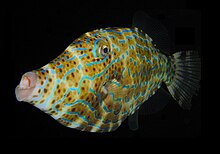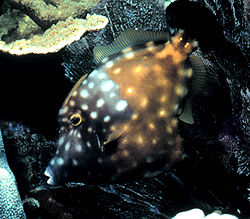
The Tetraodontiformes are an order of highly derived ray-finned fish, also called the Plectognathi. Sometimes these are classified as a suborder of the order Perciformes. The Tetraodontiformes are represented by 10 extant families and at least 349 species overall; most are marine and dwell in and around tropical coral reefs, but a few species are found in freshwater streams and estuaries. They have no close relatives, and descend from a line of coral-dwelling species that emerged around 80 million years ago.

Triggerfish are about 40 species of often brightly colored fish of the family Balistidae. Often marked by lines and spots, they inhabit tropical and subtropical oceans throughout the world, with the greatest species richness in the Indo-Pacific. Most are found in relatively shallow, coastal habitats, especially at coral reefs, but a few, such as the oceanic triggerfish, are pelagic. While several species from this family are popular in the marine aquarium trade, they are often notoriously ill-tempered.

The Redtoothed triggerfish is a triggerfish of the tropical Indo-Pacific area, and the sole member of its genus. Some other common names include blue triggerfish, redfang triggerfish, redtoothed filefish, and Niger triggerfish.

Amanses scopas, also known as the broom filefish, is a filefish, the only species in the genus Amanses of the family Monacanthidae. It is also called brush-sided leatherjacket in Australia or broom leatherjacket in Christmas Island.

The Zeidae are a family of large, showy, deep-bodied zeiform marine fish—the "true dories". Found in the Atlantic, Indian, and Pacific Oceans, the family contains just six species in two genera. All species are important and highly regarded food fish supporting commercial fisheries, and some—such as the John Dory —are enjoyed in large public aquaria. These fish are caught primarily by deep-sea trawling.

The smooth leatherjacket or velvet leatherjacket, Meuschenia scaber, is a filefish of the family Monacanthidae, found off eastern Australia and all around New Zealand to depths of about 100 m (330 ft), on rocky weedy reef areas. Its length is between 25 and 31 cm. In New Zealand it is simply known as leatherjacket as it is the only fish of this family commonly found there, by the Māori language name kōkiri, or by its commercial name cream fish.

The orange-lined triggerfish is a demersal triggerfish. Although Balistapus is a monotypic genus, it is closely related to the genus Balistoides.
This glossary of ichthyology is a list of definitions of terms and concepts used in ichthyology, the study of fishes.

Aluterus scriptus, commonly known as scrawled filefish, broomtail filefish or scribbled leatherjacket, is a marine fish belonging to the family Monacanthidae.

Cantherhines dumerilii is a species of fish in the family Monacanthidae, the filefishes. Its common names include whitespotted filefish, barred filefish, orange-fin file, and yelloweye leatherjacket. It is distributed in the Indian and Pacific Oceans where it is found on coral reefs.

Aluterus schoepfii, the orange filefish, is a species of fish in the family Monacanthidae. The species can also be listed under the family Balistidae. They can reach a maximum size of 62 centimetres (24 in) although they are common to 40 centimetres (16 in).

Stephanolepis is a genus of bony fish in the family Monacanthidae, the filefishes. Members of this genus are unusual-shaped fish and have a very rough skin which gives them their common name. They are laterally flattened and deep bodied with long dorsal and anal fins and a fan-shaped tail. They have a mouth at the tip of the projecting snout and a long spine on the top of the head.

Stephanolepis cirrhifer, commonly known as the thread-sail filefish, is a species of marine fish in the family Monacanthidae. It is found in the western Pacific, in an area that ranges from northern Japan to the East China Sea, to Korea. Other common names for the fish include kawahagi (カワハギ,皮剥) (Japanese) and “쥐치” "Jwi-chi" (Korean). The fish grows to a maximum length of about 12 inches, and consumes both plant material and small marine organisms like skeleton shrimp. S. cirrhifer is host of the parasite Peniculus minuticaudae. Some minor genetic differentiation between S. cirrhifer born in the wild and those bred in a hatchery for consumer use has been shown. The fish is edible and sold commercially for culinary purposes in many Asian countries.

Stephanolepis hispidus, the planehead filefish, is a species of bony fish, a ray-finned fish in the family Monacanthidae.

Monacanthus chinensis, commonly known as the fan-bellied leatherjacket or fantail leatherjacket, is a species of filefish native to the western Pacific Ocean and the eastern Indian Ocean where it is found on reefs and soft sediments at shallow depths. This species grows to a total length of 40 centimetres (16 in).

Cantherhines pardalis is a species of fish in the family Monacanthidae, the filefishes. Common names include honeycomb filefish, honeycomb leatherjacket, and wire-netting filefish. It is native to the Indian Ocean, the eastern Atlantic, and the western Pacific, except for the seas around Hawaii, where it is replaced by Cantherhines sandwichiensis.

Acreichthys tomentosus, commonly known as the bristle-tail filefish or Aiptasia-eating filefish, is a species of demersal marine fish which belongs to the family Monacanthidae and is widespread throughout the tropical waters of the Indo-west Pacific. It is a small fish that can reach a maximum size of 12 cm (4.7 in) length and has the ability to rapidly change color and skin texture and patterns as to avoid detection and consequently predation. It is oviparous.

Monacanthus ciliatus, commonly known as the fringed filefish, the cuckold or the leather-fish, is a species of bony fish commonly found in shallow water in the western Atlantic Ocean, the Caribbean Sea and the Gulf of Mexico.

The orangespotted filefish is a species of filefish described by Ranzani in 1842. and it is native to shallow waters in the tropical and subtropical Atlantic Ocean, the Caribbean Sea and the Gulf of Mexico.

Stephanolepis diaspros, commonly known as the reticulated filefish or the reticulated leatherjacket, is a species of bony fish, a ray-finned fish in the family Monacanthidae. Its natural range is the western Indian Ocean but it is also one of the species which has colonised the Mediterranean through the Suez Canal by Lessepsian migration from the Red Sea.





















